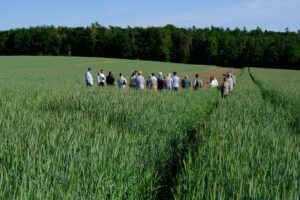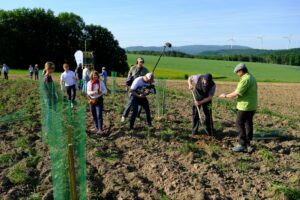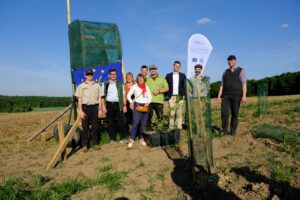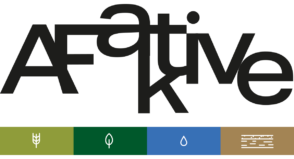Agroforestry planting at Hofgut Neumühle
Agriculture and forestry are almost always managed separately in Germany. However, when combined, they create synergies and promote biodiversity and soil fertility. As a pioneer for farmers, the Hofgut Neumühle educational and experimental centre for livestock farming is dedicated to this topic and, together with the Institute for Applied Material Flow Management (IfaS) and the Hunsrück-Hochwald National Park, has established a demonstration and experimental site for agroforestry. This is part of the part of the EU-LIFE project ZENAPA (Zero Emission Nature Protection Areas). Within this framework, also the AGROfloW project, funded by the Federal Ministry of Agriculture, Food and Home Affairs (BMLEH) via the funding agency Fachagentur Nachwachsende Rohstoffe. Both projects are coordinated by IfaS. The final planting took place on the afternoon of Wednesday 14th May 2025. A camera team from the German SWR channel was also on site. Their report will be aired on 22nd May 2025 from 8:15 pm on SWR 3 Rheinland-Pfalz in the programme ‘Zur Sache Rheinland-Pfalz!’ Link.




© Photos: Bernd Junge/IfaS
Agroforestry is a sustainable land use method in which trees and/or shrubs are specifically combined with agricultural crops or animal husbandry. This creates diverse, ecologically stable and economically productive systems. The potential for stabilising agricultural yields in times of climate change with extreme weather events such as drought and heavy rainfall is enormous. Although agroforestry has long been established in many other regions of the world, knowledge of how it can be integrated into our modern agriculture is still very limited. “The Palatinate District Association [Bezirksverband Pfalz] brings together very specialised topics under one roof. We need to act with foresight in order to tackle climate change and promote climate adaptation. That is why we are very happy to support this project with its model character,” emphasised Hans-Ulrich Ihlenfeld, Chairman of the District Assembly, in his welcome address.
Six agroforestry rows with a width of 8.5 to 17 metres and a total area of around 2 hectares were planted on an arable area of around 26 hectares. The plantings serve to protect against wind and water erosion, to create a biotope network and for future energy utilisation. “The trees will be harvested after 6 years at the earliest, chopped up and used as fuel for the wood chip heating system currently under construction at the Neumühle. The approximately 3,000 poplar saplings of six different hybrid varieties were planted mechanically and will also be harvested mechanically to enable economical biomass production,” explained Frank Wagener from IfaS. The 225 mixed-in deciduous trees from nine different tree species are used to produce valuable timber and increase the biodiversity of the tree rows.
“This Planting enables a more sustainable use of nature. In this way, we are actively working hand in hand towards the future of agriculture and forestry. I’m looking forward to the research results!” says Max Mörsdorf, Deputy Head of the Hunsrück-Hochwald National Park Authority. And Dr Jason Hayer, deputy facility manager of Hofgut Neumühle, added: “As farmers, we have to face up to the debate about our greenhouse gas emissions and take responsibility. If we adjust all the levers, we can move towards climate neutrality.” Also present at the final planting were Dr Klaus Weichel, First Deputy Chairman of the Palatinate District Assembly, Rudolf Jacob, Mayor of the Palatinate Association of Municipalities, Harald Westrich, Commercial Director of LUFA Speyer, Jan Jungkind, representatives from the Rhineland-Palatinate State Forests and the Research Institute for Forest Ecology and Forestry, the DLR, the district administrations and Dr Christian Koch and Johannes Steinfort from Hofgut Neumühle.
